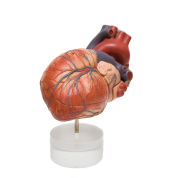Headphones Could Play Havoc with Pacemakers
Author: tiger Published Under: Health
What is a Pacemaker?
 The first implantable pacemak
The first implantable pacemaker was not developed until 1958, but doctors had been experimenting with the effect of electricity on the heart for some time. In 1889 a British scientist studied the effect of an electrical shock on the heart. He observed that it was possible to use the shocks to literally force the heart to beat.
The term pacemaker was coined by Albert Hyman in the 1930’s. Hyman invented a device that was hand powered and could be used to stimulate the heart. He called his invention an Artificial Pacemaker.
The first implanted pacemaker had a pretty short operating life. Only three hours after being implanted, the pacemaker stopped working. The next one lasted only two days, but over time the average lifespan has greatly improved. Today, most pacemakers last around eight years, but this can be decreased if it is used frequently.
Arne Larsson was the first person to ever receive a pacemaker. He died in 2001 at the age of 86, after having 26 different pacemakers during his lifetime.
In modern pacemakers, electrodes are attached to the heart, which stimulate the heart. A pacemaker can be used to fix a persons heart rate if it beats too slowly or to fix other heart problems. It helps to promote a regular heartbeat.
The pacemaker can be largely configured by doctors, allowing them to regulate how often or under what instances the device engages. Some artificial pacemakers also include a defibrillator. While a pacemaker is designed to ensure a regular heartbeat, a defibrillator is used to jump start the heart in the event of a heart attack. An implantable defibrillator can be configured to detect cardiac arrest and save the life of its user.
What Devices Interfere With Pacemakers
The report, released by Dr. William Maisel, indicates that most headphones can negatively effect the way a pacemaker works. The study, which was completed in Boston at the Medical Device Safety Institute, found that when placed within 1.2 inches of the heart, a set of headphones could cause a pacemaker malfunction.
About 25% of participants experienced a malfunction, with those using a pacemaker and defibrillator were twice as likely to experience problems. The magnet in the headphones is the culprit, but when worn on the head, they do not post a problem. It is only if the headphones were placed close to the pacemaker that a problem could occur.
The report also indicated that the MP3 players themselves, such as an iPod, did not cause any complications with the participants. Blue tooth signals, which are commonly used on wireless headsets, also appear to have no effect on a pacemaker.
There are several other devices that can negatively effect someone who has a pacemaker or defibrillator. In the case of a defibrillator malfunction, this could result in the defibrillator going off and shocking its users heart.
- Metal Detectors: The types of medal detectors used at the airport, including the hand held wands can be very dangerous to people with pacemakers. Electronic Article Surveillance (EAS) systems can also cause problems. Many stores use EAS systems as a way to prevent shoplifting. A tag is placed on an item and if it is brought out of the store an alarm sounds. Some use magnetic tags, which was found to cause problems to those who use pacemakers.
- Medical Equipment: Some of the equipment used in hospitals and dentists can cause irregular behavior in pacemakers. This is one reason that those with pacemakers should always carry an identification card or medic alert bracelet. An MRI can also be incredibly dangerous, as a result of the magnets used.
- Welding Equipment: Some types of power tools and welders utilize powerful magnets to provide their power. These magnets can cause a pacemaker to malfunction.
- Radiation Treatment: Some of the types of cancer treatments that rely on therapeutic radiation treatment are known to cause problems with pacemakers. The degree to which a pacemaker is effected can greatly vary, but in many cases the radiation has cause the circuits in the pacemaker to deteriorate.
- Microwave and Short Wave Signals: Some signals that can be transmitted through the air will disturb a pacemaker. Specifically signals that utilize high-frequency and high-intensity signals.